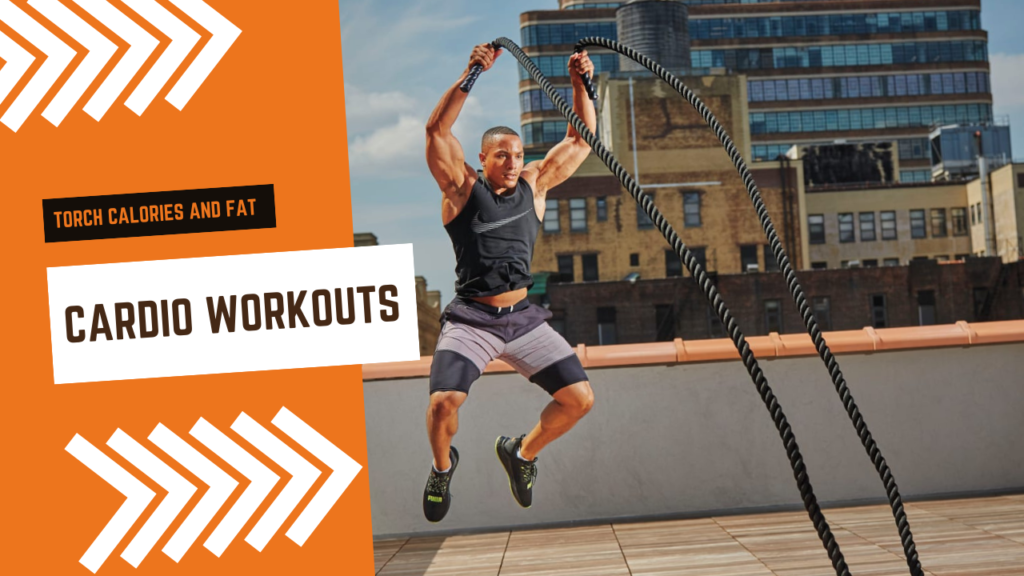Cardio Workout or cardiovascular exercise involves any activity that makes a person’s heart rate rise and sustains the increased rate for some time. Aerobic exercise enhances the work of the heart and lungs, which in other words means the efficiency of the circulatory system is increased.
Health Benefits of Cardio
A cardio workout is very beneficial to the body since it helps improve the circulation of blood thus leading to a healthy heart, it expands the lungs thus improving the breathing capacity, and generally increases the endurance of an individual. Evaluating available information, the report has determined that people with cardiovascular disease ought to engage in regular workouts to decrease the likelihood of persistent conditions like heart disease, stroke, and type 2 diabetes.
Additional Health Benefits
In addition to the primary benefits, cardio exercises also contribute to:
- Lowered Blood Pressure: One of the ways that people can reduce the buildup of blood pressure is by exercising the heart through steady cardio exercise.
- Reduced Triglycerides: Cardio exercises are useful in the reduction of their levels in the blood hence having a low-density lipoprotein that does not cause heart diseases.
- Reduced Blood Glucose: Cardio activities assist in controlling blood sugar levels thus playing a crucial role in people with diabetes.
Cardio and Weight Loss
Effectiveness of Cardio for Weight Loss
Cardio indeed proves very beneficial in shedding off the pounds as it aids in calorie loss. Cardio helps create a calorie deficit, which is the basis of weight loss, as well as in the additional calories burned during the workout and in its after-effects.
How Cardio Aids in Appetite Regulation
Adding cardio exercises is the solution, as the type of exercise can affect the hormones that make one feel hungry. It also showed that practicing cardio can make the levels of ghrelin, the appetite stimuli, decrease while the levels of peptide YY, the hunger inhibiter, rise.
Post-Exercise Oxygen Consumption and its Impact
The final point of this powerful prose is the fact that during the periods after graduating from an intense cardio exercise, the body goes on burning calories. This, which is called excess post-exercise oxygen consumption (EPOC), indicates that you will carry on eliminating calories even after the exercise session is over.
Optimizing Cardio for Fat Loss
How Much Cardio is Enough to Lose Weight?
As for aerobic exercises to be performed, for weight loss, it is recommended that one should perform at least 150 minutes of moderate-intensity exercises per week or 75 minutes of high-intensity exercises per week. This can be divided into 30-minute sessions that are taken five times a week or just shorter intense sessions.
Cardio vs. Diet for Weight Loss
As important as it is to have cardio, diet also has an important function in the process of slimming down. Dieting and cardiovascular exercises produce the best outcomes when they are taken in conjunction with one another. Balanced meals are beneficial to you in the sense that you feed the body right while sticking to your calorie budget.
Common Struggles with Cardio and Weight Loss
That is why many people suffer from such problems as stagnation, tiresomeness, and injuries if they use only cardio for weight loss. Thus, to avoid such obstacles, one has to change the types of workouts frequently, include strength exercises, and have enough rest between the training sessions.
Integrating Strength Training
Benefits of Strength Training for Weight Loss
Adding strength-training exercise to cardio exercise because it helps make the body slim and also contributes to weight loss. Strength training is the best training in terms of losing weight because it enables the development of muscles, thereby raising basal metabolic rate, meaning that more calories will be burned even when you are idle.
Popular Cardio Exercises
Gym-Based Cardio Exercises
Treadmill: A versatile machine that allows for running, walking, and interval training.
Stationary Bike: Offers a low-impact workout, ideal for individuals with joint issues.
Rowing Machine: Provides a full-body workout, engaging multiple muscle groups.
Elliptical: Low-impact cardio that mimics the motion of running without the stress on joints.
At-Home Cardio Workout
- Running/Jogging: Simple and effective, requiring no equipment.
- Jumping Rope: A high-intensity workout that improves coordination and burns calories quickly.
- HIIT: High-intensity interval Training involves short bursts of intense exercise followed by rest, making it a time-efficient workout.
Top Fat-Burning Cardio Workout
Running and Jogging
Jogging and running are two of the best cardio workout for burning calories. By using the whole body, these exercises increase cardiovascular endurance and significantly increase calorie burn.
High-Intensity Interval Training (HIIT)
HIIT workouts alternate between rest intervals and periods of high-intensity training. This approach is a great way to lose weight since it increases the amount of calories burned both during and after exercise.
Jumping Rope
A high-intensity workout like jumping rope can burn up to 1300 calories in an hour. Additionally, it enhances cardiovascular health, agility, and coordination.
Cycling
Riding a bike, either outdoors or on a stationary cycle, is a great way to burn calories and strengthen your heart while still being easy on your joints.
Swimming
Swimming is an effective full-body exercise that burns a lot of calories. People with joint pain or injuries can benefit most from it.
Stair Climbing
Climbing stairs is a strenuous exercise that works the muscles in the lower body and burns a lot of calories. Additionally, it increases endurance and cardiovascular fitness.
Kickboxing
Kickboxing is a high-intensity workout that tones muscles and burns calories by combining strength and cardio training.
Rowing
A great full-body exercise that works both the upper and lower bodies is rowing. It enhances cardiovascular health and burns a large amount of calories.
Effective Cardio Routines
Sample HIIT Workouts
- On a treadmill: alternate for 20 to 30 minutes between one minute of sprinting and two minutes of walking.
- Elliptical: For 20 minutes, alternate between 30 seconds of maximal effort and 1 minute of moderate exertion.
- Bike: For 25 minutes, alternate between 30 seconds of vigorous riding and 1 minute of leisurely biking.
Jump Rope Beginner Exercises
Jump rope for one minute at a time, then take a 30-second break. As your endurance increases, progressively lengthen the duration.
25-Minute Stair Climber Endurance Workout
Start with a moderately paced 5-minute warm-up. For fifteen minutes, up the ante and alternate between high and moderate exertion. Take the remaining five minutes to cool down.
21-Day Rowing Machine Workout Plan
First Week Plan
| Day | Workout | Details |
| Day 1 | Steady-State Rowing | 20 minutes at a moderate pace |
| Day 2 | Interval Training | 2 min hard rowing, 3 min easy rowing, repeat 4 times |
| Day 3 | Endurance Focus | 25 minutes steady rowing |
| Day 4 | Recovery Day | Light stretching and mobility exercises |
| Day 5 | Pyramid Intervals | 1 min easy, 2 min moderate, 3 min hard, 2 min moderate, 1 min easy, repeat 2 times |
| Day 6 | Long Row | 25 minutes of steady rowing |
| Day 7 | Active Recovery | Gentle rowing or rest day |
Second Week Plan
| Day | Workout | Details |
| Day 1 | HIIT | 20 minutes of rowing with resistance intervals |
| Day 2 | Strength Focus | 35 minutes of steady rowing |
| Day 3 | Endurance Challenge | 20-sec sprint, 10 sec rest, repeat 8 times |
| Day 4 | Recovery Day | Light stretching and mobility exercises |
| Day 5 | Tabata Intervals | 40 minutes of continuous rowing |
| Day 6 | Long Distance | 20-sec sprint, 10-sec rest, repeat 8 times |
| Day 7 | Active Recovery | Gentle rowing or rest day |
Third Week Plan
| Day | Workout | Details |
| Day 1 | Pyramid Intervals | 2 min easy, 3 min moderate, 4 min hard, 3 min moderate, 2 min easy, repeat 2 times |
| Day 2 | Endurance Focus | 25 minutes of rowing with varied intensity |
| Day 3 | Recovery Day | Light stretching and mobility exercises |
| Day 4 | Power Intervals | 1 min hard rowing, 1 min rest, repeat 10 times |
| Day 5 | Strength and Endurance Combo | 50 minutes of continuous rowing |
| Day 6 | Endurance Test | 50 minutes continuous rowing |
| Day 7 | Celebration and Reflection | Easy rowing or rest day, reflect on progress and achievements |
Combining Cardio with Other Exercises
Jump Squats
Jump squats combine strength training and cardio, targeting the lower body and increasing heart rate for effective calorie burn.
Running/Walking Intervals
Compared to steady-state running, alternating between running and walking increases cardiovascular endurance and burns more calories.
Stationary Bike Sprints
Perform short, intense sprints on the stationary bike, followed by periods of low-intensity pedaling to maximize calorie burn.
Burpees
Burpees are a full-body workout that mixes cardio and strength training to provide a rapid, high-intensity burn of calories.
Jumping Jacks
A quick and easy cardio workout that increases heart rate and burns calories is jumping jacks.
Cardio for Targeted Fat Loss
Can Cardio Reduce Belly Fat?
Regular cardiac exercise can help reduce overall body fat, especially belly fat, even though spot reduction is a fiction. To effectively target resistant fat locations, a combination of strength training, cardio, and a nutritious diet is recommended.
Best Cardio Exercises for Targeting Specific Areas
It is advised to combine a range of aerobic workouts for total fat loss. Running, cycling, and swimming are especially good exercises to target areas of fat that are difficult to lose.
Maintaining Motivation and Consistency
Tips for Staying Motivated with Cardio Workout
- Set Realistic Goals: Establish achievable milestones to stay motivated.
- Variety is Key: Mix different cardio exercises to prevent boredom.
- Workout Buddy: Exercising with a friend can make workouts more enjoyable and hold you accountable.
- Track Progress: Keep a workout journal or use fitness apps to monitor your progress and celebrate achievements.
How to Track Progress and Celebrate Milestones
- Use Fitness Apps: Track your workouts, calories burned, and progress over time.
- Set Milestones: Celebrate reaching specific fitness goals, such as running a certain distance or completing a challenging workout.
- Reward Yourself: Treat yourself to something special when you achieve your fitness milestones to maintain motivation.
Conclusion
Incorporating cardio workout into your fitness routine is essential for achieving weight loss success and overall health benefits. From improving cardiovascular health and lowering blood pressure to reducing blood glucose levels, cardio exercises offer a myriad of advantages. By understanding the effectiveness of cardio for weight loss, optimizing your workout routines, and integrating strength training, you can maximize your fat-burning potential.
Engaging in popular cardio exercises such as running, HIIT, jumping rope, and swimming ensures that your workout remains varied and effective. Additionally, combining cardio with other exercises like jump squats and burpees can enhance your results. Remember, consistency and motivation are key to maintaining your fitness journey. Set realistic goals, track your progress, and celebrate your achievements to stay motivated.


